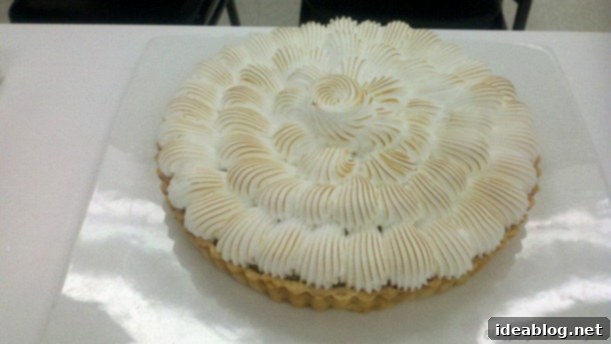Culinary School Journey: Day 5 – Mastering Classic French Techniques, Potages, and Confit
Stepping into the bustling culinary school kitchen today, I quickly realized a crucial oversight: my camera’s memory card was still nestled in my laptop at home. While a minor setback, it meant relying on my cell phone for capturing the day’s culinary explorations. Though my phone takes decent photos, it certainly added an extra layer of challenge to documenting the intricate processes and expanding array of dishes we tackled. As our menus grow more sophisticated and our techniques more demanding, photographing every stage of the cooking journey becomes increasingly difficult, yet vital for reflection and sharing.
A Day of French Culinary Immersion: Potage, Remoulade, and Zest Confit
Day Five of our intensive culinary program brought forth a slightly less frantic pace compared to yesterday’s intricate demands, yet it was undeniably rich in new techniques and profound learning experiences. Our curriculum included a comforting French potage, a vibrant salad featuring celery root and apple dressed in a homemade remoulade, and a refreshingly light dessert of oranges accompanied by exquisite zest confit. Each dish offered unique insights into the precision and artistry of classic French cuisine.
Crafting the Classic Potage Julienne Darblay: A Creamed Potato and Leek Soup
Our featured soup for the day was a delicate creamed potato and leek soup, traditionally known as Potage Julienne Darblay. Enthusiasts of French cuisine might recognize its cold counterpart, vichyssoise. This seemingly simple soup introduced us to several new pieces of equipment and advanced techniques crucial for achieving its signature velvety texture and refined flavor profile.
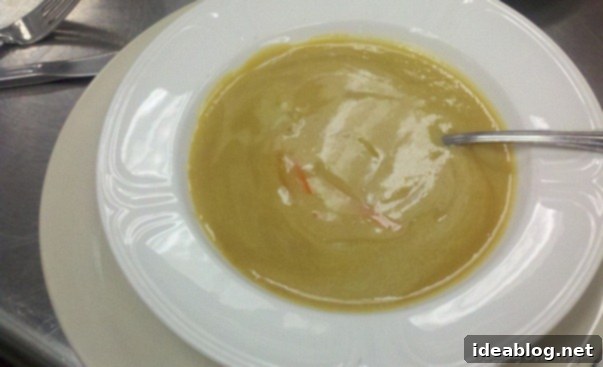
The preparation began by gently “sweating” the leeks in butter until tender, ensuring they softened without gaining any color – a crucial step for a pale, elegant soup base. This was followed by adding high-quality stock and a traditional bouquet garni, a carefully bundled sachet of fresh herbs and spices (typically peppercorns, fresh thyme, parsley stems, and a bay leaf) encased in cheesecloth, designed to infuse the broth with aromatic depth without leaving any solids. Roughly chopped potatoes were then added, and the mixture was simmered slowly until perfectly tender.
Once cooked, the entire mixture was transferred to a high-speed blender for processing until exceptionally smooth. The true magic, however, happened next: straining the soup through a chinois. This conical, extremely fine-mesh strainer, which we had not encountered until today, proved indispensable for achieving an utterly silken, impeccably smooth texture. While an investment, the results a chinois yields are undeniably superior, elevating the soup to a professional standard.
The Art of Julienne Darblay and Etuvée: The Perfect Garnish
Adding another layer of elegance to our potage was the julienne darblay garnish, prepared using a special cooking technique called ETUVÉE. This French term, meaning “to smother,” perfectly describes the method: finely julienned carrots, celery, and leeks are placed in a small saucepan with a minimal amount of stock and butter. They are then covered with a CARTOUCHE—a parchment paper lid cut precisely to the pan’s diameter and pressed directly onto the vegetables. This allows the vegetables to cook very slowly over extremely low heat, steaming in their own juices until exquisitely tender, without caramelizing or acquiring any color. This technique ensures the garnish remains crisp-tender and visually appealing, offering a delightful textural contrast to the creamy soup.
New Culinary Insight: Garnish vs. Décor
A fascinating clarification emerged today regarding the precise definitions of “garnish” and “décor.” Contrary to my initial understanding, a garnish is not merely an item added for presentation; it’s an integral component *added* to a dish, enhancing its flavor, texture, or visual appeal, though not necessarily part of the primary cooking process. In our potage, the finely julienned *étuvée* vegetables were a perfect example of a garnish. Décor, on the other hand, refers strictly to elements used solely for aesthetic decoration at the final plating stage, without contributing significantly to the dish’s flavor profile. This distinction is vital for understanding professional plating and recipe construction.
A Kitchen Calamity: The Case of the Vanishing Garnish
Despite mastering these new techniques, the day wasn’t without its challenges. My partner and I had meticulously prepared our julienned vegetables for the garnish, leaving them off the heat and ready for plating. However, upon returning to plate our soup approximately 30-45 minutes later, we were dismayed to find our precious garnish reduced to a burnt, evaporated crisp. It appeared another student had mistakenly reactivated our burner, incinerating our perfectly cooked vegetables. With no time to remake them, our potage, as seen in the photograph, sadly lacked its intended vibrant garnish. This unfortunate incident served as a stark reminder of the dynamic, often unpredictable, nature of a busy professional kitchen and the absolute necessity of vigilant attention to every pot and pan. A valuable, albeit frustrating, lesson learned!
Celery Root and Apple Remoulade Salad: A Mayonnaise Derivative
Accompanying our potage, we crafted a refreshing salad composed of julienned celery root and crisp apple, generously tossed in a homemade remoulade. We learned that remoulade is a classic small or derivative sauce of mayonnaise, which meant another opportunity to practice our homemade mayonnaise skills! For our remoulade, we incorporated finely minced capers, anchovies for a subtle umami depth, piquant cornichon pickles, fresh parsley, and aromatic chervil. The vibrant salad was then elegantly served on a bed of peppery arugula. It presented an intriguing combination of flavors and textures—distinctly European and quite tasty, though perhaps not a staple I would replicate regularly at home.
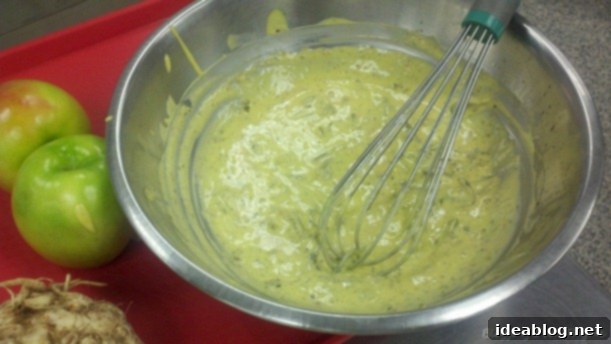
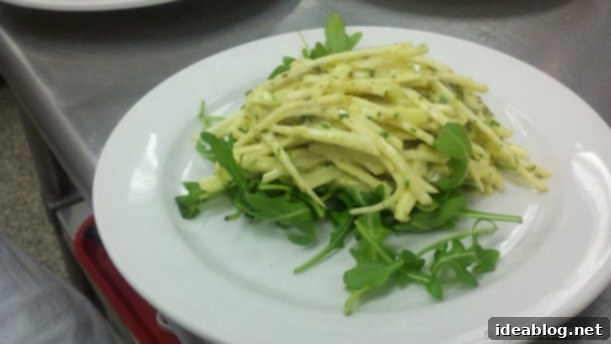
Delicate Citrus Salad with Zest Confit: Candied Orange Peel
Our light and elegant dessert for the day was a beautiful citrus salad featuring oranges and a delicate zest confit—essentially candied orange peel. As elucidated in our morning lecture, the term “confit” fundamentally means “to cook,” typically achieved through two primary methods: cooking in sugar or cooking in fat. A prime example of the latter is duck confit, where meat is slow-cooked in its own rendered fat to achieve incredible tenderness and flavor. Zest confit, conversely, involves cooking the zest and peel of citrus in sugar, specifically a simple syrup.
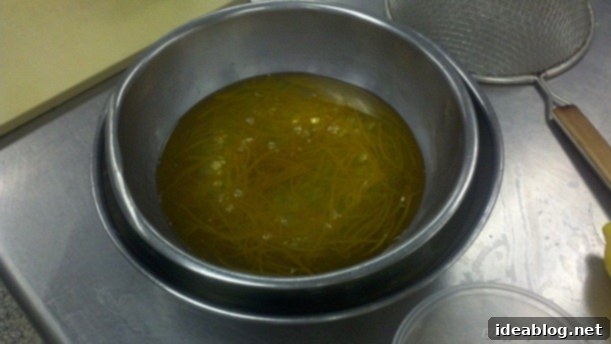
The process began by meticulously peeling our oranges, ensuring only the zest and a minimal amount of pith were removed. The peel was then very finely julienned. A critical step followed: blanching the peel three times. In our school’s parlance, blanching specifically means “cleaning” or removing impurities by submerging in boiling water, distinct from “par-boiling.” Each blanching cycle involved starting with fresh cold water, bringing it to a rolling boil, and then refreshing the water. This repeated process is absolutely vital, as it effectively extracts the natural oils from the peel and eliminates any inherent bitterness, leaving behind a clean, pure citrus flavor. Finally, the blanched peel was simmered gently in a simple syrup (equal parts sugar and water) until it became tender and translucent, losing any gummy texture.
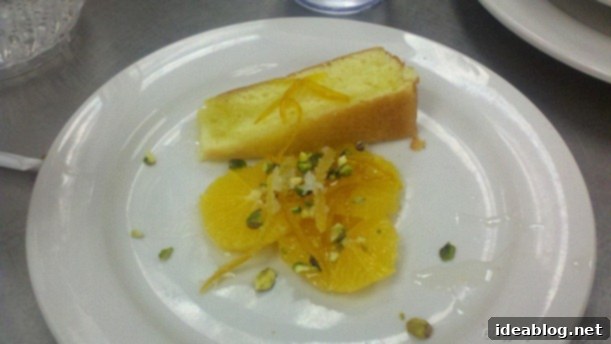
The remaining orange flesh was then skillfully prepared using the “peler a vif” technique, which involves segmenting or slicing the citrus by removing all outer pith and membrane. Today, instead of segments, we opted to slice the oranges into elegant coins. Meanwhile, half of our zest confit was kept submerged in its simple syrup, while the other half was removed, allowed to dry slightly, and then lightly tossed in granulated sugar—creating truly delightful candied orange peel.
For plating, we artfully arranged the orange slices, topping them with a little of the zest confit in syrup, a few strands of the sugared zest, and a sprinkle of chopped pistachios for crunch and color. To complete the dessert, we added a small slice of the genoise cake we learned to bake yesterday, moistening it further with a spoon of simple syrup. The simplicity of the concept belied the exquisite flavor; these oranges were truly delicious and a testament to the power of fundamental techniques.
Afternoon Demos and Extracurricular Insights
Lunch and a thorough clean-up followed our morning practical session – a task that, to my recurring surprise, again included cleaning the immense stockpot! The afternoon then transitioned into an exciting demo focusing on breaking down whole chickens, a skill I’ve long yearned to master.
Mastering Poultry Butchery: From Whole Chicken to Cuts
As someone with virtually no experience in meat butchery, I was incredibly keen on this session. Chef Brian’s expert demonstration of deboning and sectioning a whole chicken was both insightful and inspiring. Afterwards, each student was provided with their own chicken and a boning knife to follow suit. While I found some aspects relatively straightforward, certain parts, such as cleanly removing the chicken breasts and the elusive “oysters” (small, succulent pieces of dark meat near the thigh bone), proved quite tricky. This is definitely a skill I plan to practice diligently over the weekend. I’m excited by the prospect of being able to butcher poultry at home now, ensuring fresher cuts and greater control over my ingredients.
Behind the Scenes: A Magazine Recipe Photo Shoot
Though class officially concluded on time at 2:30 PM, I had eagerly volunteered to stay until 5:30 PM to assist our chef instructor with a recipe photo shoot for Bethesda Magazine – an opportunity perfectly aligned with my interests! The featured recipe was a rich and savory duck, andouille, and shrimp gumbo. My role involved extensive prep work, from precise vegetable chopping to organizing the mise en place, and then assisting during the actual cooking process. Post-shoot, I helped with the arduous clean-up.
This experience offered invaluable insights. Not only did I further refine my knife skills, but I also gained a firsthand look at the meticulous, step-by-step process of photographing a recipe for publication. The absolute highlight, however, was being a taste tester at the end. The gumbo was incredibly flavorful and comforting – I wished I could have taken it all home! I even secured the recipe, so recreating this masterpiece is definitely on my agenda once I gather all the necessary spices.
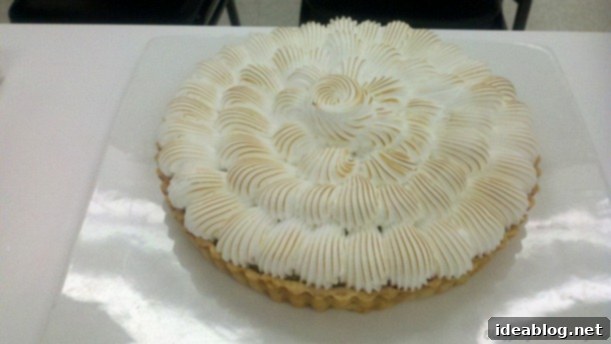
During my extended stay, I also had the pleasure of tasting a small slice of a stunning lemon meringue tart, masterfully crafted by the pastry students (seen above). It was a perfect harmony of intensely tart lemon curd crowned with a cloud of soft, marshmallow-like meringue. Learning that we will be tackling this delicious creation in a future class fills me with eager anticipation.
Looking Ahead: Sanitation Certification and Food Safety
Looking forward, I’m delighted to report that tomorrow morning offers a welcome reprieve with an extra 30 minutes of sleep! The next two days, encompassing the remainder of Week 2, are dedicated exclusively to sanitation training. During this crucial period, we will immerse ourselves in learning comprehensive food safety rules and regulations, ultimately working towards our food manager certification. This means we won’t need to arrive early to assist with kitchen prep, allowing for a slightly more relaxed start to the day. I’ve been warned to brace myself for a series of eye-opening, and perhaps somewhat “disgusting,” stories as we delve into the importance of hygiene and safety in a professional kitchen. I’ll be back soon with all the details from this essential phase of our culinary education!
